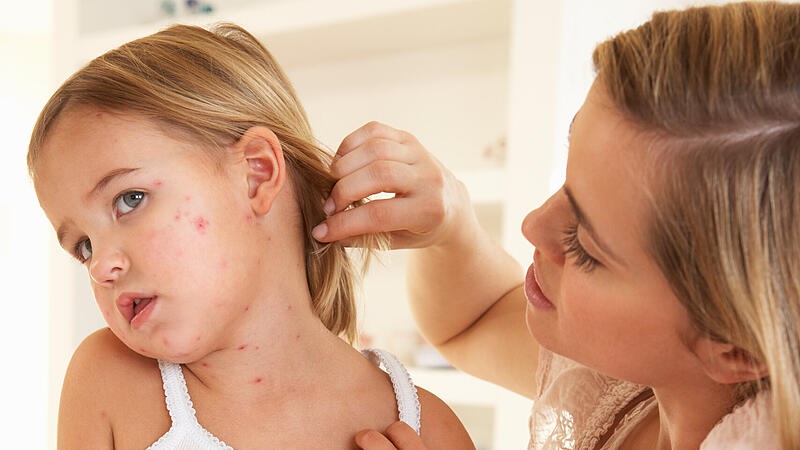Image: colourbox.de
The increasing cases of measles in Austria are due to falling vaccination rates. As can be seen from an answer to a query by Health Minister Johannes Rauch (Greens), the number of combination vaccinations against measles-mumps-rubella (MMR) has fallen significantly since 2020 – and thus since the beginning of the corona pandemic. While there were 338,240 doses called up for vaccination in 2019, there were only 174,907 doses in 2020 and only 158,897 doses in 2021.
- More on this: Measles and dangerous ignorance
- also read: “Measles is a disgusting disease that we should eradicate”
In 2020, only 25 cases of measles were reported in Austria, and one case each in 2021 and 2022. According to a 2022 report by the Ministry of Health, pandemic control measures have greatly reduced the introduction and transmission of measles virus. Last year saw a resurgence of measles infections, with 186 cases reported, according to the Agency for Health and Food Security (AGES). This year, as of February 13th, there are already 75 confirmed cases in the epidemiological reporting system (EMS). A further increase is to be expected, according to AGES. With appropriately high vaccination rates, the measles virus could be eradicated. For this to happen, 95 percent of the population would have to be immune, emphasized the Ministry of Health.
There are always vaccination gaps
Now the answer to the written question by NEOS health spokeswoman Fiona Fiedler regarding ensuring good vaccination rates in Austria shows that for the MMR vaccination in 2018, the federal states still accessed 210,016 doses from the respective framework agreements via the Federal Procurement GmbH (BBG). The period from February 1st to January 31st of the following year is always calculated. In 2019 there were 338,240 cans, but only 174,907 in 2020, 158,897 in 2021, 174,281 in 2022 and 108,936 cans retrieved from February to July 2023. Only the vaccine that is actually needed is called up. However, it may be that the number of doses retrieved does not correspond to the number of vaccinations administered.
MMR vaccination rates have been determined since 2015 using an agent-based dynamic simulation model, the Ministry of Health explained. That’s why these values are not given in absolute numbers, but in percent. Also for the reason that there is no registration requirement for MMR.
There have been repeated vaccination gaps in recent years. According to the ministry report, it was shown that the number of vaccinations administered in 2022 – these are the most current values - increased again, so that very young children in particular were increasingly vaccinated again in 2022. On the other hand, age groups with low vaccination rates have not yet been able to sufficiently catch up. There are still too few children in Austria vaccinated in a timely and consistent manner with the recommended two doses.
Good vaccination coverage among young children
From the age of 9 months, two doses of the MMR vaccination are recommended. If the first vaccination is in the first year of life, the second dose should be administered after three months. Ideally, as many children as possible should be vaccinated in their first year of life, but in any case before entering community facilities such as daycare or kindergarten. In 2022, the one-year-olds already had a vaccination coverage rate of 82 percent for the first partial vaccination. This is significantly better than the year before, when only 71 percent of the one-year-old children received a first partial vaccination. However, with the second partial vaccination, the vaccination rate drops to 45 percent. Among the one-year-olds, 18 percent, i.e. 15,500 children, are completely unvaccinated. Ideally, a vaccination rate of 95 percent should already be achieved in this age group by the second vaccination, which is not nearly the case.
According to the 2022 report, in the two to five year old age group, it appears that small children were not sufficiently vaccinated in previous years. Eight percent of children in this age group are now completely unvaccinated, so the goal of a 95 percent vaccination rate cannot be achieved even with the first partial vaccination. Only around 87 percent of the children have already received the second vaccination. Specifically, this means that almost 19,000 children in this age group are missing at least the second partial vaccination and another 28,200 children have not yet received any vaccination at all. The children born in 2019 and 2020 in particular have low vaccination rates.
“Due to increasing vaccine skepticism, measles is on the rise again”
According to the report from 2022, in the six to nine year old age group, vaccination rates are above the targeted 95 percent, at least for the first dose. For the second dose, however, it is still only just under 90 percent. In total, around 30,700 children only received the first and not the second vaccination. Ten to 18 year olds are generally very well vaccinated. Here, the goal of a 95 percent vaccination rate is even achieved with the second dose of vaccination.
“Due to increasing vaccine skepticism, measles is on the rise again”Minister Rauch complained about the situation on the platform X (formerly Twitter). “My appeal: Have your vaccination status and that of your children checked and, if necessary, get your vaccination now. For the sake of your health. It is not for nothing that vaccinations are one of the greatest achievements in medicine.”
The measles virus is a highly contagious single-stranded RNA virus that belongs to the paramyxovirus family, AGES warned. Infected people are considered contagious from about four days before to four days after the characteristic measles rash appears. The highest risk of infection is in the prodromal phase, the phase before the rash appears, which lasts 2-4 days and is characterized by a strong cough. Possible complications of a measles infection include bacterial superinfections with middle ear infections, pneumonia, or inflammation of the larynx. The susceptibility to tuberculosis is also increased. In one to two out of 1,000 cases, a life-threatening inflammation of the brain occurs, which is fatal in ten to 20 percent of cases and is associated with permanent damage to the nervous system in 20 to 40 percent.
My themes
For your saved topics were
new articles found.

info By clicking on the icon you can add the keyword to your topics.
info
Click on the icon to open yours “my themes” Page. They have of 15 keywords saved and would have to remove keywords.
info By clicking on the icon you can remove the keyword from your topics.
Add the topic to your topics.
Source: Nachrichten




